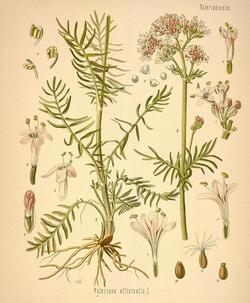This is an old revision of the document!
Valerian-Valeriana Officinalis
image source:http://www.botanical.com/botanical/mgmh/v/valeri01.html
Its a hardy perennial flowering plant, with heads of sweetly scented pink or white flowers. The flowers are in bloom in the northern hemisphere from June to September. Valerian was used as a perfume in the sixteenth century. Native to Europe and parts of Asia, Valerian has been introduced into North America. It is consumed as food by the larvae of some Lepidoptera (butterfly and moth) species including Grey Pug. Other names used for this plant include garden valerian (to distinguish it from other Valeriana species), garden heliotrope (although not related to Heliotropium) and all-heal. The garden flower red valerian is also sometimes referred to as “valerian” but is a different species, from the same family but not particularly closely related.http://en.wikipedia.org/wiki/Valerian_%28herb%29
The roots tend to merge into a short, conical root-stock or erect rhizome, the development of which often proceeds for several years before a flowering stem is sent up, but slender horizontal branches which terminate in buds are given off earlier, and from these buds proceed aerial shoots or stolons, which produce fresh plants where they take root. Only one stem arises from the root, which attains a height of 3 or 4 fee
The plant prefers light (sandy), medium (loamy) and heavy (clay) soils. The plant prefers acid, neutral and basic (alkaline) soils. It cannot grow in the shade. It requires moist soil.It is in flower from June to August, and the seeds ripen from July to September. The flowers are hermaphrodite (have both male and female organs) and are pollinated by Bees, flies, beetles. http://www.pfaf.org/database/plants.php?Valeriana+officinalis

